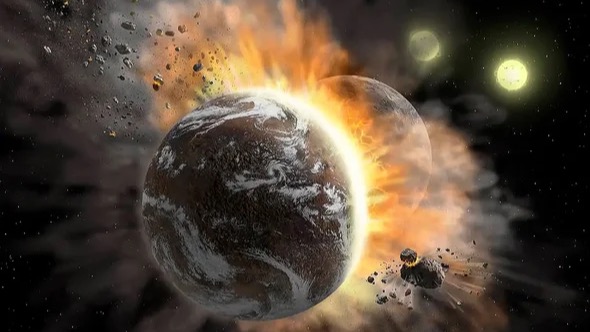
According to a Dutch astronomer, we might have just seen the aftermath of two giant planets colliding in a distant star system. However, other astronomers have other explanation for the observations. Which is true?
Seeing the unthinkable with our own eyes
Read any account that details the beginning of our solar system and most will eventually mention collisions between planets being a regular occurrence. While they are talked about a lot, we have never seen one actually occur before. That might have just changed with recent discoveries using NASA’s NEOWISE space telescope and a world wide network of ground base telescopes.
Matthew Kenworthy, an astronomer at the Leiden Observatory in the Netherlands, and one of the lead authors of the paper, was the one that started the journey to this moment. He responded to an alert from the All-Sky Automated Survey for Supernovae (ASAS-SN) project, a network of small telescopes around the world that look for early signs of supernovae. Usually before stars become a supernova, they become much dimmer and this is what ASAS-SN is looking for.
The alert came from a star much like our Sun 1,800 light years from Earth that was going through an almost complete dimming.
However, things got weird after Kenworthy shared the finding on social media. An amateur astronomer named Arttu Sainio, who came to be a co-author of the paper, shared he found data from NASA’s NEOWISE telescope of a large increase in infrared light by the same start just a few years ago. It isn’t normal for star like ours to undergo both an increase in infrared light and then immense dimming so close to each other. His only theory was some sort of planetary collision followed by a debris field.
The two planets that collided were expected to be similar to our ice giants Uranus and Neptune. It’s hard to wrap our heads around this as a possibility but we’ve seen evidence that these collisions are rather common in young star systems. For the first time, scientist get to see this sort of event take place right in front of our eyes.
In a few millions of years, the debris field will consolidate into a new planet and possibly moons. Kenworthy states they have already witness two white-hot metal-rich cores combine into one in a matter of days.
Kenworthy’s paper, however, still has to be validated.
Join our Discord Server: Join the community with forums and chatrooms about space!
The other explanation
Not every one is onboard with Kenworthy’s explanation of the sudden brighting then dimming. One part that doesn’t exactly line up is the temperature observed during the believed impact of the two planets. The numbers show about 1,000 kelvin when a direct impact between two planets of those kinds should be closer to 2,000 to 3,000 kelvin. Kenworthy’s explanation is a possible glancing blow between to planets rather than a head-to-head one.
Jonathon Marshall, a research scholar at the Academia Sinica Institute of Astronomy and Astrophysics in Taiwan, has another theory into what happen. Using a different process, Marshall determined the the system was much older than Kenworthy, five billion years old versus 300 million. The much older age of the system would make planetary collisions extremely uncommon compared to younger ones.
Marshall believes the data also lines up with fragments of a comet transiting the star. These are much more common and lines up with spectrum measurements showing a make up of a comment rather than a planet. “There’s nothing to say that it isn’t a planet-planet collision — but it’s important to consider all possibilities,” Marshall said.
Marshall’s paper also need to be validated.
More data will be needed to determine which paper is correct. NASA’s James Webb Space Telescope could be used to help determine if it was a comet or the first planet collision ever witnessed. But we’ll have to wait for time to open up on it to find out.
FTC: We use income earning auto affiliate links. More.

Comments